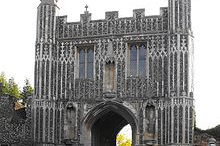Colchester: Long lost report rewrites history for Abbey Gatehouse

Abbey Gatehouse
A local historian in Colchester, Essex, with a particular interest in the 14th century Abbey Gatehouse has made an exciting discovery about its history. Jennie Guthrie-Stevens was looking through records in the museum library when she came upon a copy of the report made when the dilapidated building was refurbished in the 1840s.
The building is the only part of the 12th century Benedictine Abbey to survive from the Reformation when the Abbey was suppressed by King Henry VIII.
The report makes clear that much of the material used in the repairs of the 14th century building was not Victorian, as currently thought, but came from the original abbey itself.
"This is a hugely exciting find," says Guthrie-Stevens. "No-one seems to have been aware of the report, which I found at the back of a cabinet. It is a copy of the original which was sent by the engineer's grandson, a man called Montagu, to the secretary of the Officers Club in 1952. The Club was built upon the Abbey site after the 1840s refurbishment. The original report may have been lost when the Club burnt down three or four years ago.
The report is incredibly detailed, she says, and shows that as much Abbey material as possible was reused in the Gatehouse in a way faithful to the original.
"We always thought the gates were Victorian but it seems that they are the original gates dating from the time of the Abbey itself. The engineer reused bosses, coping stones and finials from the Abbey ruins and incorporated pieces of medieval glass into the windows. The tracery and most of the window surrounds themselves were still intact at the time. Evidently the little angels in the archway were from the original Abbey too."
The report also gives new information about aspects of the building which have gone unnoticed. Guthrie-Stevens continues: "He was able to identify remnants of the religious statues of Our Lady and the lilies that surrounded her in the flint work, traces of the statue of St John the Baptist and the carvings around the niche in which the statue stood and a bit of another statue which may have been of an abbot."
Even the source of the wood used in the repairs is cited: bought as two oaks from a Mr Pound. The report also attests to the later history of the site: the writer mentions seeing bullets in the walls of the building, dating from the Cromwellian siege of Colchester.
Guthrie-Stevens is a member of the Colchester Catholic Heritage Group, which is based in the parish of St James the Less and St Helen, has been heavily involved in research on the abbey and the story of the last abbot, who was executed outside its walls on the orders of Henry VIII. The aim of the group, which is associated with Colchester Museum, is to promote the heritage and wider understanding of Catholics' place in history and the community of the town. The group recently won accreditation and an award from the Arts Council.
The award was given to allow the group to display artefacts in the church and fund a web page linked the museum. It is also intended to fund training and research. For the past two years the group has been looking for other funding to enable it to bring the Gatehouse back into regular use. The building has already been used for Masses on the anniversary of the last abbot's execution and opens regularly for English Heritage weekends. The group gives talks and provides information on these occasions.
Says Guthrie-Stevens: "We desperately need funds to improve access to the building through the installation of a handrail on the steep spiral stairs, and electricity."
The attention to detail of the Gatehouse refurbishment and the evident desire to ensure that the restoration was as true to the original as possible suggests that the perpetrator was ahead of his time. It may have been a labour of love too.
"I suspect the writer of the report may have been a Catholic," says Guthrie-Stevens, "as he refers to one of the statues as the Blessed Virgin holding the Saviour." She believes that the initials 'EM' found on the wall beside the Gatehouse are probably those of the person responsible for its renovation - or possibly even its survival.


















